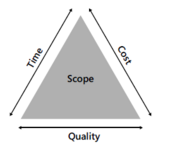Scheduling techniques in Project Management
(→INTRODUCTION TO THE PROJECT MANAGEMENT) |
|||
| Line 14: | Line 14: | ||
According to the PMI® - Project Management Institute there are five steps to determine the entire managing flow of the process from the beginning to the end: | According to the PMI® - Project Management Institute there are five steps to determine the entire managing flow of the process from the beginning to the end: | ||
| − | *1. Scoping
*2. Planning *3. Executing *4. Controlling *5. Closing. | + | *1. Scoping
|
| − | + | *2. Planning | |
| − | + | *3. Executing | |
| + | *4. Controlling | ||
| + | *5. Closing. | ||
=REFERENCES= | =REFERENCES= | ||
<references /> | <references /> | ||
Revision as of 11:10, 12 September 2015
“The Project Management is a management system that aims to results”.[1] The goal of a project can only be reached through precise scheduling techniques that take into account all various constraints such as time and economic resources. Techniques such as PERT, CPM and GANTT are the most used to plan into details a project, prevent uncertainties and avoid risk. These three techniques complete each other and offer a wide range of scenario that could occur during the development of a project The aim of the scheduling techniques is to reach the goal on time without wasting precious and limited resources. On the other hand it’s an important tool to prevent in advance future situations and to promptly identify future issues that can compromise the success of the project. Thought the use of these techniques all the single steps of a project are defined in advance, the goals are clear and the resources are properly allocated.
INTRODUCTION TO THE PROJECT MANAGEMENT
“A project is a sequence of unique, complex, and connected activities that have one goal or purpose and that must be completed by a specific time, within budget, and according to specification.” [2] Every project has therefore constraints that can be summed up into the Project Management Triangle.
Every project has therefore constraints that can be summed up into the Project Management Triangle. The most important interlinked constraints of a project are: time, cost and quality. Figure XX shows that the value of two constraints, they determine the third one. For example, you can build a house quickly with a really high quality but it will cost heaps. On the other hand, you can choose to save up and reduce costs and build it in short time but the quality won’t be excellent. Through this example, it can be understood that projects has to deal with limitations and with compromises. Managing and supervising a project is not an easy job and its management is the crucial issue. "The Project Management is the application of knowledge, attitudes, techniques and tools to the activities that form a project to reach successfully the goals." [3]
According to the PMI® - Project Management Institute there are five steps to determine the entire managing flow of the process from the beginning to the end:
- 1. Scoping
- 2. Planning
- 3. Executing
- 4. Controlling
- 5. Closing.
REFERENCES
- ↑ Miscia S., 1994, Il Project Management, Quaderni di Formazione Pirelli, Milano.
- ↑ Robert K. Wysocki, 2009, Effective Project Management: Traditional, Agile, Extreme. Fifth Edition. [Available online on Google books] pag. 6 https://books.google.it/books?id=AQifszBiJe8C&pg=PA6&lpg=PA6&dq=“A+project+is+a+sequence+of+unique,+complex,+and+connected+activities+that+have%E2%80%A8one+goal+or+purpose+and+that+must+be+completed+by+a+specific+time,+within%E2%80%A8budget,+and+according+to+specification.”+reference&source=bl&ots=vxN9JNFKlB&sig=0CWyn9uoUdxCWrP8bH2Db56BbPQ&hl=it&sa=X&ved=0CEIQ6AEwBGoVChMIzd6u-ovxxwIVircUCh0YgQKk#v=onepage&q=“A%20project%20is%20a%20sequence%20of%20unique%2C%20complex%2C%20and%20connected%20activities%20that%20have%E2%80%A8one%20goal%20or%20purpose%20and%20that%20must%20be%20completed%20by%20a%20specific%20time%2C%20within%E2%80%A8budget%2C%20and%20according%20to%20specification.”%20reference&f=false
- ↑ Project Management Institute, 2000, A guide to the Project Management body of knowledge
